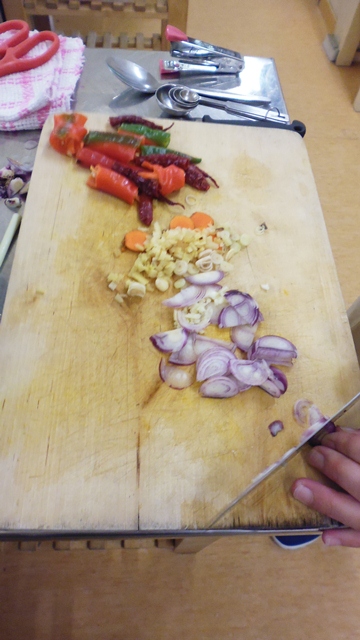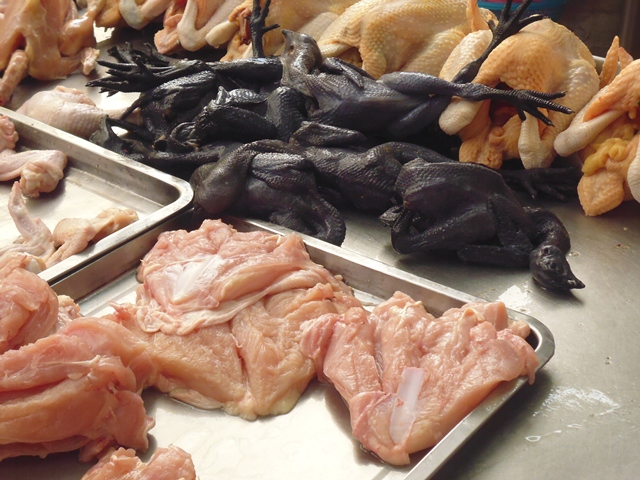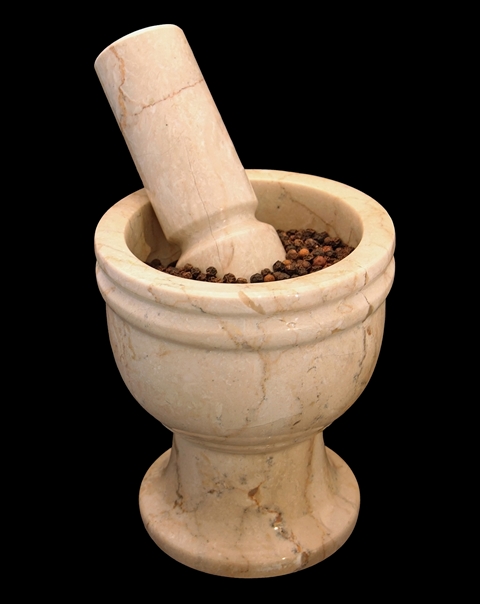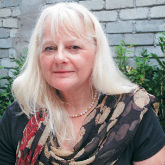One of the best things about Penang is its food but most often the only way to take it back home is to learn how to cook it for yourself. Frances Wilks sampled some of the cookery lessons on offer and learnt how to cut lemongrass, pound galangal, and turn rice blue.
Fusion Food

Southeast Asia has the ultimate fusion food. Way back before the term was invented, patterns of migration blended different cuisines and this delectable inheritance is something that Penangites enjoy sharing very much indeed. But the traffic hasn’t always been one-way. I had always thought that, along with spices, chili was an Asian thing which Europeans had adopted. But it turns out that it’s not true. Hot chilies come from the Americas, not Asia, and it seems that Europeans actually brought them East in the first place. Of course, they were looking for spices, and Penang played a pivotal role in the spice trade, which is reflected in many of the local dishes.
The other great influence is the arrival of the Chinese who adapted some Malay culinary customs. This, in turn, gave rise to the Nyonya tradition of cookery. It has elements of both cultures, with a dash of India and Thailand. But it is not an easy style of cooking to master and you really need a teacher not a recipe book.
Black Chickens and Spectacle Nuts

As any cook will tell you, before you even start to prepare a meal, you have to source the right ingredients. Pearly Kee, one of the best-known Nyonya cooks in Penang, starts her cookery classes with a market tour. “Watch your backs,” she cries enthusiastically, “This is a busy market. Here are diff erent types of gourds – both the snake and bottle varieties. Cook them with garlic and tumeric. Look at this amazing watercress, the Japanese call it Sayorumi and it’s really a miracle food, it has all the minerals in it.” She shows us different types of chicken, including strange looking black ones, which haven’t been dyed, they’re just that way naturally.
Pearly takes us to the fish ball and fish mince stall and explains that they are essential ingredients. “But it’s better to buy them here because these people really know how to make them and it’s quite time consuming.” Not to mention smelly I would imagine, if shrimp paste, the essential ingredient of sambal belachan (a tasty “must have” accompaniment to so many Nyonya dishes) is anything to go by. But it doesn’t do to be too fussy about ingredients. Pearly explains that the century old eggs we are admiring are actually infused with horse’s urine. My reaction is disgust until I remember that hormone replacement therapy is often made from the same substance. Pearly is keen on the link between food and medicine, believing that eating well is an essential part of being healthy. She shows us spectacle nuts, wickedly demonstrating them as a pair of spectacles against her face. “They’re very good for de-toxifying the kidneys,” she says.
But if you really want a miracle spice, then look no further than galangal. It’s sometimes known as blue ginger and as well as being a natural antibiotic, it is also anti-parasitic and performs a really important task in our polluted world – it removes heavy metals from the body. It is also great for older people as it helps arteries and blood vessels to keep their elasticity. The only problem with galangal is that it is tough and woody. It has to be smashed before it releases its goodness. First you have to chop it finely to a matchstick size before pounding it in a pestle and mortar or blender.
As well running her own home cookery school, Pearly teaches at the Tropical Spice Garden’s Cooking School. Surrounded by the fragrant breezes of the Spice Garden and overlooking the sea, this is one of the most atmospheric and hands on places to learn to cook. On the way up to the hill, I see the ultramarine blue pea flower growing and one of the gardeners tells me that it’s used to make rice blue. Like many spices it’s an anti-inflammatory, and it’s also said to be good for hair and eyesight. You steep the flowers in water until you get the hue you desire and then soak the rice in the water before cooking.
Pestle and Mortar or Blender?

One of the great debates is whether you should pound or blend spices to make pastes, the basis for so much South-east Asian cuisine. In the old days cooks used a pestle and mortar or a batu giling – a granite slab over which a roller was slid up and down – to create a smooth paste. It was hard work, recalls Pearly describing the pestle and mortar she had to use every day as a child for grinding chillies as her enemy. “I had to use both hands, and the chili would be flying into my eyes.” Small wonder then that nowadays she uses a blender to create a paste. She feels the taste is pretty much the same and that it’s much quicker and more convenient. Her tip is to chop the ingredients as finely possible before placing them in the blender and then add water to a third of the height of the paste.
On the other hand, Devi Nadarajan, who also teaches at the Tropical Spice Garden’s Cooking School, is more of a traditionalist. She encourages her students to use a pestle and mortar and believes that the extra eff ort is worth it because it will bruise the flavour out of the spices more effectively and thus create a more fragrant paste. Also the water that you have to add to a blended paste may dilute the flavour. But you have to factor in the convenience of using a blender, especially when you’re pressed for time. Devi shows me how much of the lemongrass stick to use. “Cut off the bottom and the top then discard the outer husks and use the white part only.” She shows us how to cut it finely before placing it in the pestle and mortar. She also persuades us to arrange our boards neatly so that we can cook without stress.
With the chopping and grinding out of the way, the actual cooking can start. This is where it gets really aromatic. The smell of spicy pastes, laden with garlic and onions, makes your mouth water. We’re making a Thai green curry. Once the paste has cooked then the chopped chicken is added and some coconut milk. While that’s simmering we add the finishing touches to a green papaya kerabu with peanuts – a “chilified” salad full of crunch and flavour. A few more minutes and and we’re ready to sit down and consume this steaming, delicious feast with a side of rice.
For more details on Pearly Kee’s market tours and cookery classes, contact her on [email protected] Tropical Spice Garden Cooking School’s website www.tropicalspicegarden.com/spice-cooking-school
Read more:
- 11 Incredible Food Displays by a Malaysian Artist
- 7 Famous Dishes from Ipoh You Should Try
- 10 “Unique” Delicacies Available in Malaysia
What are your thoughts on this article? Let us know by commenting below. No registration needed.
Source: Penang International October 2014-March 2015
"ExpatGo welcomes and encourages comments, input, and divergent opinions. However, we kindly request that you use suitable language in your comments, and refrain from any sort of personal attack, hate speech, or disparaging rhetoric. Comments not in line with this are subject to removal from the site. "


















Wonderful article. Thanks for sharing. We were in Penang last week and just can’t get enough. we will defo do the cooking next time! See pics! https://viveashphotography.wordpress.com/2015/01/21/personal-work-malaysia-penang-george-town/